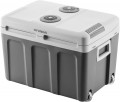Volume
The volume of the working chamber of the car refrigerator. The larger the volume, the more products can be loaded into the unit at a time. When choosing according to this parameter, it makes sense to select a model with a margin, because it is not recommended to load products too tightly — this adversely affects the quality of the device. On the other hand, note that the volumetric container and dimensions will have the appropriate ones.
Operation mode
—
Cooling. A mode of operation in which the food placed inside is cooled to a temperature just above zero (the minimum threshold is usually around 4 °C). Present in all car refrigerators by definition.
—
Freeze. An operating mode designed to cool the food placed in the cooking chamber to a temperature below zero (in some models down to -18°C). In some models, it can also be used for making ice in special compartments.
—
Heating. The mode of operation for heating products is especially useful in the cold season. Many models with this function have fairly good heating characteristics, allowing you to heat food in them to a hot state. This mode is also good for keeping food hot. However, car refrigerators with a heating function are usually quite expensive.
Max. heating at
An indicator of how many degrees the refrigerator is able to heat the product placed in it relative to the ambient temperature (if there is a heating function). Suppose a product at a temperature of +15 °C is placed in a refrigerator with a maximum heating of 60 °C; thus, the temperature of the product at the end of heating will be 75 °C, which is more than enough for the perception of food as warm and its comfortable consumption.
Keeping temperature for
The maximum time during which the temperature inside the working chamber of the refrigerator can remain unchanged when the cooling units are turned off. The low temperature hold time is usually indicated when using the so-called cold accumulators — pre-chilled blocks with water or other coolant. The actual temperature retention time depends on many factors and often differs from those stated in the specifications (usually downward), but this parameter can be used to compare different models with each other.
Energy label
A parameter that characterizes the efficiency of energy consumption. In modern car refrigerators, there are classes from A + and above; the more “pluses” in the marking, the more economical the device.
Note that the energy class does not describe the actual power consumption, but the efficiency of the device compared to similar models. Therefore, for example, a large
built -in A++ class unit may consume more energy than a smaller A+ class
armrest refrigerator.

